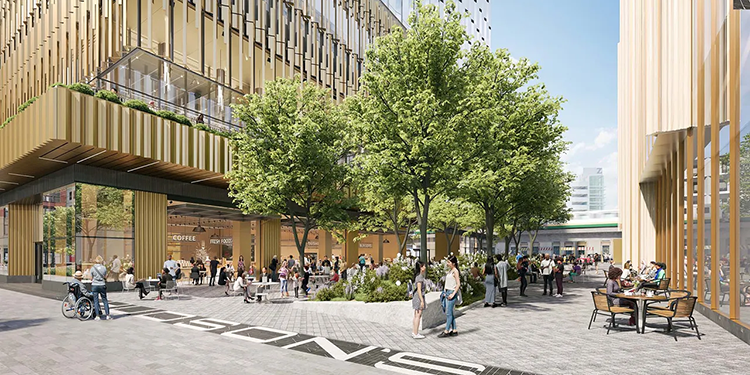
May 16, 2022
How Detroit-based Architect Saundra Little, FAIA, Designs for Her City
Christina Sturdivant Sani | TopicA
By Christina Sturdivant Sani
After co-founding Detroit-based Centric Design Studio and operating it for a decade, Saundra Little’s firm was acquired by Washington, D.C.-based Quinn Evans Architects in early 2019. With more than 15 years in the industry, Little had designed several notable projects at that point, including design-build renovations at Burton International Academy, a Detroit public school, and the award-winning design of the David Klein Gallery. The acquisition of Evans’ company landed her the role of principal in Quinn Evans’ Detroit office.
Three years earlier, Little’s history and documentation project Noir Design Parti was selected as one of Detroit’s winners in the 2016 Knight Foundation Arts Challenge. The project, which she conceptualized with historian and diversity and inclusion advocate Karen Burton, documents the careers and creative works of Detroit’s African American architects.
Most recently, Little accepted the position of director of diversity, equity, and inclusion at Quinn Evans. “I’m interested in seeing how I can continue to move the needle in architecture for minorities in the profession,” she says. She also serves as the Midwest Vice President of the National Organization of Minority Architects.
Read on to learn about her passion for community development and history, the challenges on her road to becoming an architect, and vision for Noir Design Parti.
How would you describe your niche as an architect?
All roads lead to history. I work on a lot of adaptive reuse projects, and I do some new construction, but everything is in the community neighborhood setting. So I would say any project that has a community or historical impact.
Do you have any favorite projects?
I’ve done three co-working spaces: TechTown, SpaceLab Detroit, and then a concept for an art co-working space that hopefully gets built out in the next year. I like coworking spaces because I used to be a small business owner, and I feel like coworking spaces level the playing field for anybody starting a business. It gives you access to amenities that most small business owners who are bootstrapping can’t get, and it gives you a leg up.
A new favorite under construction now is Allied Media Projects. It is a four-story renovation to a warehouse building here in Detroit. The vision of the project is led by each of the tenants, who are all nonprofits.
Total accessibility for the building has been the focus of this renovation. They didn’t go straight for LEED certification but had sustainability, accessibility, and inclusive design in mind. I can’t wait for that project to be completed. It was just great working alongside an owner with a vision like that.
What initially sparked your interest in architecture?
It started with an interest in art and drawing, but I’ve found that along the way, there have been different things that led me to architecture without me even realizing it.
For instance, I visited a building that Nathan Johnson designed as a kid, and I was struck by the mid-century modern [design] and how he created this odd-shaped window without any structural kind of emphasis at this corner. And he completely framed out a view of the neighborhood.
What have been some of your biggest challenges on the road to becoming an architect?
It was tough not knowing a lot about the profession before heading into it in college. I didn’t have a mentor who could give me words of wisdom. My family was like, ‘Are you sure you want to be an architect? Nobody in our family is an architect.’ Though I didn’t have any support, I just went for it. And I’m lucky that I made it.
Why did you choose Noir Design Parti for your Knight Foundation submission?
Karen Burton and I had been talking about it for a long time. We always heard people say, ‘I didn’t know of any Black architects until I met you.’
But I came up through firms that were minority-owned. And I was like, how did they not know these people? I’ve also heard about Black architects from the trailblazing generations before me [who had] retired by the time I started to practice. So I was like, we have to get this out here because I don’t want to hear that anymore.
What have you enjoyed most about the project?
It’s been great seeing them highlighted and telling their stories. Just being the first of anything is history-making. Nathan Johnson started his practice in 1954 right in the middle of the Civil Rights movement. There were only two or three architecture firms in the state of Michigan at that time that were Black—so that’s just remarkable to me.
We recently made it a focus of the project to write letters of recommendation for Black architects for AIA awards. So just to see these people get awards while they’re still living has really meant a lot to me.
Where do you see [this project] going in the future?
Now that we’ve gathered all this information, it needs to be archived [in] a place where people can look and learn about how Black architects did a lot of things against all odds. I’m also interested in getting a book done so we can have a print version of what we’ve been researching.
Have you been able to outline your priorities as Director of DEI at Quinn Evans?
Trying to figure out the pandemic and this position at the same time has been interesting. But one of the goals for this year is to come up with objectives for the position and the firm.
One of the things that got me very interested in Quinn Evans when we were talking about the acquisition was that, as of April of this year, Quinn Evans will be a woman-owned firm. A 200-person firm that’s woman-owned interested me three years ago, and to see it really come to light this year is going to be amazing. I think that’s going to be a great attraction for diversity when others hear about the big changeover in April.



